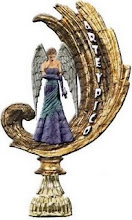I shoved them into some containers in the garden, and left them to it. As you probably know, when you leave many Chlorophytum to their own devices, the first thing they do is to produce plantlets. They are viviparous, like certain sorts of reptiles, in that they produce active offspring, rather than a seed or an egg. Isn't viviparous a wonderful word? It sounds ever so slightly sinister.
In a rare moment of prudent horticultural housewifery, I gathered up the plantlets in late summer and carefully chucked them into a glass tank vase (the only thing I had to hand) where they have lurked ever since. They're on a fairly sunny window sill and they get topped up regularly with (hard) tap water to a depth of about half an inch. Amazingly, they have thrived.
The plantlets in their glass tank. When I first detached them four, erm, months ago, the biggest one was only about two inches high
Even more amazingly, the ones in the garden are also thriving, despite night temperatures of around -2C (28F) in London. They are still producing plantlets, too.
My Chlorophytum are not the common spider plant, C. comosum 'Variegatum' but a darker, greener version, with more organised fine white stripes. I think they are C. bichetii but if any experts out there know better, please say. Apparently, they are hardy down to -6.6C (20F) and so is their spidery cousin. Who knew? If I hadn't got them so cheap at Chelsea, I would never have dared leave them to take their chance in what has so far been quite a cold winter by London standards.
Strangely enough, I hate spider plants indoors (as does the Garden Monkey, according to this post), though I can see why they are very popular. They are virtually unkillable. However, C bichetii make brilliant outdoor container plants. They always look fresh and green, even on the sultriest summer day, or the murkiest December afternoon. They make a lovely neat frill along a path, or in a window box. Just one on its own in a small terracotta pot looks good, and of course, the dangly plantlet bits make them ideal for hanging baskets.
The most fascinating thing I discovered about Chlorophytum while researching this post however, is that there is an aphrodisiac species. It's called Chlorophytum borivilianum and it comes from north-western India, where it is traditionally used in Ayurvedic medicine. It's better known by the name Safed Musli.
It's only the roots of this particular species that are said to contain the aphrodisiac properties, however. So there's no point munching down your spider plants.
Above, a single C. bichetii in a terracotta pot. The surrounding plants are, clockwise from left, Echeveria glauca, Chamaerops humilis, Fascicularia (might be pitcairnifolia) and Ophiopogon planiscapus 'Nigrescens'. This is quite a sheltered bit of the garden, very close to the house and facing south.
Below, two C. bichetii in windowboxes, either side of a cordyline and another echeveria. These pictures were taken yesterday, when the temperature was 2C (36F)
A closer view of the righthand windowbox. The babies (top righthand corner) look as if they're trying to make a break for freedom by scrambling up the fence. The tumbling mass of greenery is Erigeron karvinskianus, or Mexican daisy, one of my favourite plants of all time. Behind that is some jasmine














